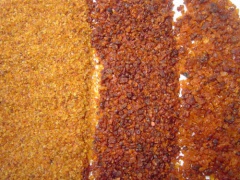Shellac
| Infobox on Shellac | |
|---|---|
| Example of Shellac |  |
| Facts | |
| Origin | India, Thailand |
| Stowage factor (in m3/t) | - |
| Humidity / moisture | - |
| Ventilation | - |
| Risk factors | See text |
Shellac
Description / Application
Shellac is a resin secreted by the female lac bug, on trees in the forests of India and Thailand. It is processed and sold as dry flakes, which are dissolved in ethyl alcohol to make liquid shellac, which is used as a brush-on colorant, food glaze and wood finish. Shellac functions as a tough natural primer, sanding sealant, tannin-blocker, odour-blocker, stain, and high-gloss varnish. Shellac was once used in electrical applications as it possesses good insulation qualities and it seals out moisture. Phonograph (gramophone) records were also made of it during the 78-rpm recording era which ended in the west during the 1950s.
From the time it replaced oil and wax finishes in the 19th century, shellac was one of the dominant wood finishes in the western world until it was largely replaced by nitrocellulose lacquer in the 1920s and 1930s.
Shellac is a natural bioadhesive polymer and is chemically similar to synthetic polymers, and thus can be considered a natural form of plastic. It can be turned into a moulding compound when mixed with wood flour and moulded under heat and pressure methods, so it can also be classified as thermoplastic.
Shellac scratches more easily than most lacquers and varnishes, and application is more labour-intensive, which is why it has been replaced by plastic in most areas. But damaged shellac can easily be touched-up with another coat of shellac (unlike polyurethane) because the new coat merges with and bonds to the existing coat(s). Shellac is much softer than Urushi lacquer for instance, which is far superior in regards to both chemical and mechanical resistance.
Shellac is soluble in alkaline solutions such as ammonia, sodium borate, sodium carbonate, and sodium hydroxide, and also in various organic solvents. When dissolved in alcohol blends containing ethanol or methanol, shellac yields a coating of good durability and hardness.
Liquid shellac has a limited shelf life (about 1 year), hence it is sold in dry form for dissolution prior to use. Liquid shellac sold in hardware stores is clearly marked with the production (mixing) date, so the consumer can know whether the shellac inside is still good. Alternatively, old shellac may be tested to see if it is still usable: a few drops on glass should quickly dry to a hard surface. Shellac that remains tacky for a long time is no longer usable. Storage life depends on peak temperature, so refrigeration extends shelf life.
Shipment / Storage / Risk factors
Shellac is the name given to the article of commerce when manufactured into flakes. Usually shipped in bags or cases. This commodity is liable to solidify or block under changing climatic conditions or due to moisture, heat or pressure. This blocking is encouraged when low grades are mixed with better qualities. Shellac of old crop will block more readily than that of new crop. Shellac is usually shipped in a free or flaky form, but in some trades it is actually shipped in blocks. In the event of complaint of blocking, evidence should be obtained to show whether or not the shellac was shipped in a solidified condition, or has become solidified due to storage under the conditions mentioned above. Blocked lac is often erroneously considered to be damaged, but, while it may not be as attractive in appearance as free or flaky lac, blocking does not necessarily seriously damage or change the essential qualities of the lac. Normally lac is ground before use, whether it be in free or blocky state. Charges for grinding block lac are more than for free goods, therefore, when lac reached destination in a blocky state, the buyer incurs a loss to the extent of these higher charges. When making an assessment for loss, it should be remembered that blocking of lac is not natural, and that this is well known and appreciated throughout the world.
Lac is liable to damage by contact with water. This type of damage may be caused by lac remaining in water or by its being stored in damp and enclosed spaces. The extent of loss will depend upon the duration of these conditions. Water-damaged lac is discoloured, brittle, and can be crumbled without difficulty. This may be noticeable on the outer part of packages and its extent may be judged either by weighing the lac, if it is in free condition and therefore separable, or, when the lac is in blocky condition and therefore inseparable, by breaking the contents of a package and measuring the comparative good and damaged parts. The extent of loss by water damage is not easily determinable, because a great deal depends on the quality of the lac and the use to which it is to be put. High grades of lac, when water-damaged, may easily become totally unfit for the type of work for which they are intended. It is therefore suggested that, where practicable, the assistance of trade experts be sought in assessing water-damaged lac.
Grades
1. Orange – TN (impure), fine, superfine, heart, superior
2. Bleached and dewaxed (colourless)
Shellac (alcohol solution) is flammable.











